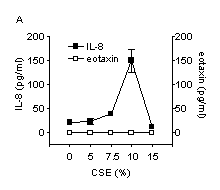| pA2 online © Copyright 2004 The British Pharmacological Society |
097P
GKT, University of London Winter Meeting December 2003 |
|
Cigarette
smoke extract (CSE) induces interleukin-8 and inhibits eotaxin release
from human airway smooth muscle cells |
|
Cigarette smoke is
the leading risk factor for the development of chronic obstructive pulmonary
disease (COPD). Accumulation of neutrophils but not eosinophils is a characteristic
feature of the inflammatory response associated with COPD (Jeffery, 1998).
We have recently shown that CSE synergises with IL-1ß in the induction
of IL-8 from THP-1 monocytes (Walters, 2003). Human airway smooth muscle
cells (HASMC) are a rich source of neutrophil as well as eosinophil specific
chemokines when stimulated with inflammatory cytokines such as IL-1ß
and TNF![]() (Chung, 2000).
However, the effect of CSE on chemokine release from HASMC has not yet
been investigated.
(Chung, 2000).
However, the effect of CSE on chemokine release from HASMC has not yet
been investigated.
HASMC were cultured from dissected bronchi removed after surgery using collagenase digestion. Cigarette smoke solution was prepared as previously described (Walters, 2003) and diluted to the required strength with DMEM. Confluent cells were exposed to CSE in the presence and absence of TNFa or IL-1ß (1 ng ml-1) at 37ºC. After 24 hrs, supernatants were collected and assayed for IL-8 and eotaxin by ELISA. All data (n=3) were obtained from one donor and are representative of two other donors. Data are expressed as mean SEM and were analysed with Students t-test.
CSE induced a bell
shape response for IL-8 release from HASMC with maximum induction of IL-8
at a concentration of 10% CSE (baseline 22.2 ± 4.8; 10% CSE 150.3
± 23.8 pg ml-1; figure 1A). TNF![]() and IL-1ß alone induced the release of IL-8 from HASMC (TNF
and IL-1ß alone induced the release of IL-8 from HASMC (TNF![]() :
456.3 ± 32.3; IL-1ß: 1796.5 ± 236.7 pg ml-1;
figure 1B). In combination with 5 % CSE, no effect was seen with IL-1ß
on the induction of IL-8 release from HASMC (IL-1ß + 5 % CSE: 2287.4
± 113.2 pg ml-1). Synergy was
observed when cells were stimulated with 7.5 % CSE and TNF
:
456.3 ± 32.3; IL-1ß: 1796.5 ± 236.7 pg ml-1;
figure 1B). In combination with 5 % CSE, no effect was seen with IL-1ß
on the induction of IL-8 release from HASMC (IL-1ß + 5 % CSE: 2287.4
± 113.2 pg ml-1). Synergy was
observed when cells were stimulated with 7.5 % CSE and TNF![]() (TNF + 7.5% CSE 973.2 ± 21.4 pg ml-1,
p<0.001).
(TNF + 7.5% CSE 973.2 ± 21.4 pg ml-1,
p<0.001).
Figure 1: Effect
of CSE, TNF![]() and IL-1ß
on IL-8 and eotaxin production by HASMC.
and IL-1ß
on IL-8 and eotaxin production by HASMC.


By contrast, CSE
did not induce eotaxin production from HASMC (figure 1A). In fact, TNF![]() -
or IL-1ß- induced eotaxin release (figure 1B) was completely inhibited
in the presence of 7.5% CSE.The results demonstrate that CSE stimulates
the release of the neutrophil chemotactic cytokine IL-8 but inhibits the
production of the eosinophil chemotactic factor eotaxin stimulated by
TNF
-
or IL-1ß- induced eotaxin release (figure 1B) was completely inhibited
in the presence of 7.5% CSE.The results demonstrate that CSE stimulates
the release of the neutrophil chemotactic cytokine IL-8 but inhibits the
production of the eosinophil chemotactic factor eotaxin stimulated by
TNF![]() and IL-1ß
in HASMC. Considering the anatomical location of HASMC with proximity
to the vasculature, these data suggest that HASMC play an important role
in promoting neutrophil migration from the vasculature to the interstitium
in lung diseases associated with cigarette smoke and may help to explain
why COPD unlike asthma, is not associated with eosinophil recruitment.
and IL-1ß
in HASMC. Considering the anatomical location of HASMC with proximity
to the vasculature, these data suggest that HASMC play an important role
in promoting neutrophil migration from the vasculature to the interstitium
in lung diseases associated with cigarette smoke and may help to explain
why COPD unlike asthma, is not associated with eosinophil recruitment.
Chung K.F., (2000).
Eur. Respir. J. 15: 961-968.
Jeffery P.K., (1998). Thorax. 53, 129-136.
Walters M.J, J.A. Mitchell, (2003). Brit. J. Pharmacol. 138,
44P.